Many people wait anxiously for the appearance of wisdom teeth. Wisdom teeth themselves do not pose a health hazard, but they often appear in the wrong place where they should be, which leads to inflammation of the gums and swelling of the mucous membranes.
Wisdom tooth occupying incorrect position in the oral cavity is called retained.
Dental abnormalities can lead to serious problems that make it difficult to speak and chew food.
Causes of improper eruption
Impacted teeth are fully formed. The reasons why they erupt in the wrong direction can be different, including:

Embryological reasons are of paramount importance. The formation of teeth occurs during the early fetal development phase.
Problems with irregularities may appear at the stage of changing baby teeth to permanent ones. If retention occurs during this period, then wisdom teeth are highly likely to grow incorrectly.
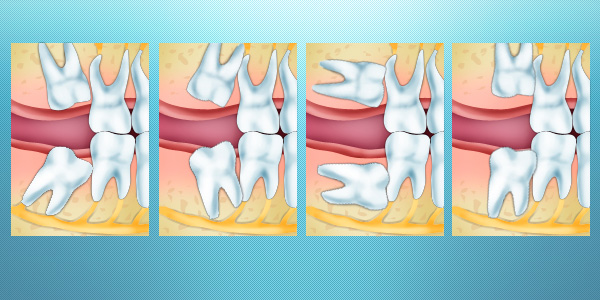
In the photo there are options for wisdom tooth growth: into the adjacent tooth, into the cheek, horizontally, straight
Features of symptoms
Symptoms of retention are very pronounced. Firstly, it is increased pain. In some cases, the pain is so unbearable that painkillers are indispensable. Secondly, there is swelling in the area of tooth formation. Impacted tooth grows crookedly and stretches the gum, causing inflammation.
Other symptoms of retention include:

Sometimes it is impossible to determine the violation externally, especially in initial stage teething. In such cases, the patient is prescribed an x-ray. Based on the image, conclusions are drawn about the degree of curvature of the molar exit trajectory and its effect on adjacent teeth.
An impacted tooth prevents normal chewing.
The close proximity of a healthy and crooked molar leads to the formation of pulpitis.
Constant irritation of the nerve endings causes unbearable pain and requires urgent medical intervention.
Retention can be complete or partial:
- When full the tooth remains inside the gum. It can only be detected through palpation and radiographic studies. Complete retention indicates that the wisdom tooth lies horizontally.
- With partial part of the tooth comes to the surface. As a rule, this occurs when the molar buds are laid at an angle. In this case, the wisdom tooth grows into the cheek, side or adjacent tooth.
Possible complications
With proper treatment, complications rarely occur. But in an advanced stage, the following processes may take place:
What to do if a tooth grows into the cheek?
Treatment of retention is possible for minor deformities. If the tooth does not erupt well due to the characteristics of the gum, then it is excised, releasing the fully formed molar out. In all other cases, tooth extraction is recommended.
 The inconvenient location of the tooth complicates its extraction. Combined with an incorrect growth trajectory, the process of wisdom tooth removal becomes even more difficult.
The inconvenient location of the tooth complicates its extraction. Combined with an incorrect growth trajectory, the process of wisdom tooth removal becomes even more difficult.
If there is an inflammatory process, before the removal operation, it is prescribed antibacterial therapy. The best time morning is considered a day for tooth extraction painful sensations must pass or decrease to an acceptable level.
The affected area is treated antiseptic composition, pain relief is performed. Drugs usually prescribed local action, but when carrying out a complex and lengthy removal, consisting of several stages, general anesthesia can be used.

The photo shows a sutured gum after removal
Next, an incision is made in the gum and the tooth is crushed into pieces. Removal individual parts is carried out in stages. After removing all parts of the tooth, the resulting wound is treated antibacterial drugs. The gum is sutured.
IN modern dentistry completely soluble materials are used, which do not require subsequent removal of sutures. The operation is considered complete after the bleeding has completely stopped.
Removing a wisdom tooth is always accompanied by a number of difficulties. Doctors recommend not delaying the removal of eighth molars due to the risk of complications. In addition, with age, the gums become significantly denser, and the roots of the tooth grow greatly.
The reason for returning to the doctor is elevated temperature three days after the operation, prolonged numbness oral tissues, putrid smell from the mouth, repeated bleeding, swelling accompanied by a hematoma, acute pain.
As a rule, these symptoms indicate the onset of inflammation caused by infection in the socket. Remaining tooth fragments and cystic formations on the tops of the roots of adjacent molars can lead to suppuration of the wound, preventing its healing.
After repeated cleaning of the hole, antibacterial therapy and preparations for home rinsing are prescribed, which should be used no earlier than one day after the operation.
Removing an incorrectly located wisdom tooth - details in the video:
Development risk inflammatory processes after removal of an impacted tooth is very large. To improve healing, dentists recommend adhering to the following rules:

How to place commas correctly in the title? What do you need to know and what to guide you when deciding whether to preserve or remove these teeth that are problematic from a dental point of view? Let's try to figure it out.
"Wisdom teeth" or “eights” usually appear in a person closer to 20 years old, plus or minus a few years (much more often plus than minus) ... Not everyone really becomes wiser by this age, but people began to call them that, hinting specifically at their late appearance. At the same time, despite the name, 8s don’t make us smarter, but we’ll get tired of listing the hassle. Why is this happening?
This is how it is in nature: everything that it does not need gradually disappears. Man has long been getting his food not in the forest, but in the supermarket, eating not raw tough meat and plant roots, but refined Big Mac... Therefore, we no longer have a great need for such quantities chewing teeth and in such large massive jaws as our ancestors had. And that’s why we are evolving in the direction of reducing jaws and the number of teeth. Even now there are many “advanced” individuals in evolutionary terms who generally lack the rudiments of the 8th teeth (and not only them, but sometimes also incisors and canines, which is less pleasant). Although still, on at the moment, this is rather an exception to general rule. But the lack of space in the jaws for all 32 teeth, on the contrary, rather a rule. And because exactly wisdom teeth are the last to appear, then they usually lack this very place in the dentition. That's why we have so many problems with them. This is just one of the factors, but perhaps one of the main ones.
Now let’s look at exactly what problems “wise teeth” can cause us.
1. Complete tooth retention.
Retention is a condition in which a tooth is various reasons could not cut through in the allotted time and in in the right place. Well, with complete retention, accordingly, the tooth does not show out at all and remains lying inside the jaw.
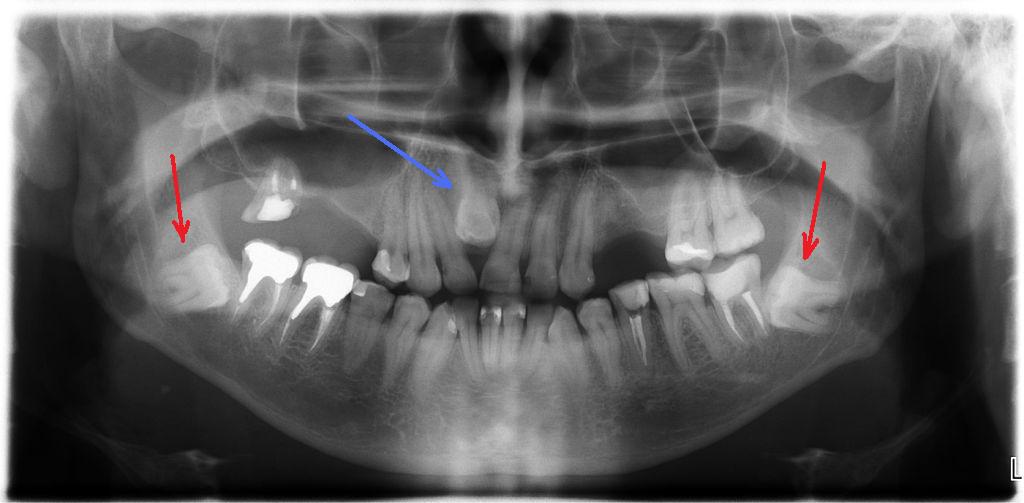
Red arrows show wisdom teeth, which lie completely in the thickness lower jaw. This is complete retention. Also, this patient, as a “bonus” from nature, received a completely retained central upper incisor(shown by blue arrow).
This arrangement could be considered quite good. Because the tooth lies inside the jaw, does not touch anyone, does not bother anyone... it would seem, and God is with it. In general, this is how it is. It’s probably not worth running as fast as you can to pick it out of your jaw. In this form, it can lie there all its life and not cause any trouble. Or maybe not entirely so. A so-called tooth may appear around such a tooth. follicular cyst. Therefore, it is best to observe such unerupted teeth by doing an orthopantomogram at least once a year *. Well... or remove such a tooth, forever forgetting about it and the need to monitor it. After all, there are many other things in life that you have to constantly think about and remember.
2. Partial retention.
By analogy, here we're talking about about those cases when the wisdom tooth was still able to partially erupt, but not completely. What most often bothers him? Either a powerful bony protrusion of the jaw, or an incorrect position of the rudiment, or a neighboring 7... in general, there can be many reasons, the essence remains the same - part of the unerupted tooth remains inside, and part sticks out outside. This is the most common situation and it is this that most often leads to various really tangible problems. Which one exactly?
- pericoronitis- perhaps the most common complication partially erupted wisdom tooth. This is inflammation in the tissues surrounding this most problematic tooth - in the gums and bone. It manifests itself as pain, swelling and redness of the gums, difficulty swallowing, and fever.
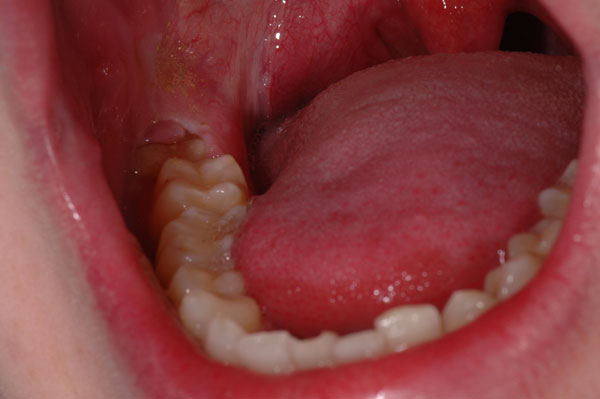
In the farthest nook of the lower jaw you can see a partially erupted 8-piece and sore gum above her.
Patients often try to self-medicate in such situations - they rinse their teeth with various drugs at hand (from chamomile decoction to five-star cognac), swallow painkillers uncontrollably, or, worse, antibiotics. Indeed, such measures (especially antibiotics) may subside the inflammation. But an unresolved cause will sooner or later lead to a relapse. Moreover, any inflammation in the area of wisdom teeth can easily develop into an abscess or phlegmon of the face and neck, and this is already serious, life-threatening surgical problems. And they are treated, among other things, by making external incisions on the face and neck. And this is really serious. I won’t insert unappetizing pictures here; a query in any search engine will help you create additional motivation to any unbelieving Thomas.
I hope I have scared you enough so that you don’t feel the urge to self-medicate in such cases. You definitely need to visit a dental surgeon. If he sees no problems in the further eruption of the figure eight, he will simply remove the gum hanging over the tooth (“hood”) and prescribe necessary medications. If the tooth objectively can no longer erupt normally, then it will need to be removed. This is the only way to eliminate the cause and protect yourself from relapses of inflammation, as well as from serious purulent complications initially a trivial problem.
- root caries adjacent 7th tooth. Often, when the 8 is “stuck” and has no chance of cutting through further, but does not bother, patients do not even think about contacting a doctor, because "It doesn't hurt." In fact, such a semi-erupted tooth makes it difficult to maintain normal hygiene in this area and this leads to caries damage to the adjacent tooth. Moreover, the most unpleasant thing about this option is that caries develops near the very base of the tooth, develops imperceptibly, the cavity for a long time may remain invisible. As a result, a huge “hole” grows, going deep under the gum, and it is not always possible to restore such a defect qualitatively. As a finale - the loss of a good neighbor due to the “wise tooth” not being removed in time. Moreover, it will be possible to make up for the lost 7 only with an implant (which is not cheap), or removable denture(which is inconvenient to use and significantly reduces the quality of life)
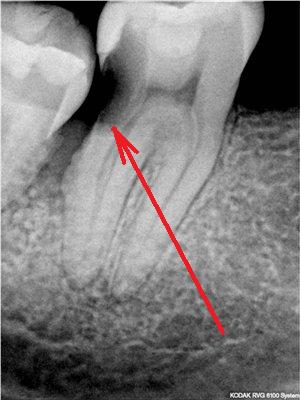
The arrow shows on the x-ray carious cavity, which arose on the 7th tooth due to its careless wise neighbor. On the right is about the same thing, only in a live photo. The stuck figure eight is shown in green, and the caries that resulted from it on the figure 7 is shown in blue.
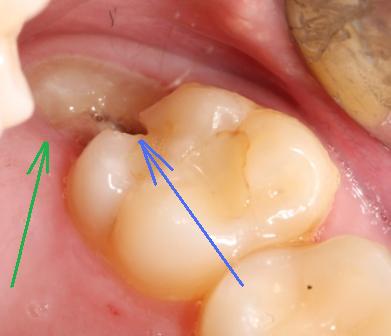
- resorption(simple resorption) root adjacent 7th tooth. In general, the situation is similar to the previous one, with the same consequences. The only difference is that, having rested against its neighbor, the “wise tooth” can turn out to be very persistent and, with its pressure on the 7th tooth, cause the resorption of its hard tissues.
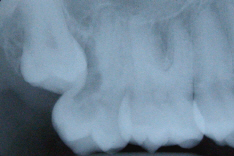
On the x-ray we see a wisdom tooth resting on the upper 7th. In the photo on the right is the same seven, after removal. This is the kind of root resorption that a stubborn wisdom tooth can cause due to its pressure.
Loss of bone from the adjacent 7th tooth... this is the third variation on the theme that behind a problematic, but seemingly not bothersome wisdom tooth, an innocent, good and necessary neighbor can easily suffer. An incompletely erupted wisdom tooth, resting against the 7-point, can create a space in which food debris will accumulate. This will cause periodontal pocket formation and bone loss between the 8th and 7th. But the result is still the same - removal of both teeth, bone grafting and implantation of the 7-piece.
![]()
Here the wisdom teeth decided to create problems for their owner as a couple. The lower one fell over and rested on the 7th, causing bone loss. The top one, deprived of his partner, crawled down to meet him. What happens from this - read on.
Chronic mucosal injury. Often crookedly erupted wisdom teeth (especially the upper ones) when chewing cause chronic injury to the mucous membrane of the cheek and gums on the opposite jaw. This is unpleasant both in itself and in terms of prognosis - any chronic injury to the same place can lead to malignancy.

Grown unevenly towards the cheeks upper (the gray arrow points to its tubercle) causes chronic injury to the mucosa (yellow arrow)
Blocking normal movements of the lower jaw with possible development problems of the temporomandibular joint. This is a rarer problem, but it still occurs. Each tooth in the dentition has its own pair on the opposite jaw - an antagonist tooth. And 8s are no exception. At removal or non-eruption of one wisdom tooth from the pair, the other, the opposite, comes forward. As a result, it can block the movements of the lower jaw and cause it to shift into an unphysiological position when chewing. This can be completely asymptomatic until symptoms begin in the joint - clicking, crunching, pain... etc.
Here the top eight lost their antagonist “thanks” to natural forces...
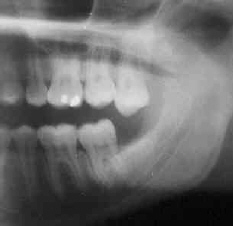
And here thanks to the strength of the dentist. True when removal one eights you should immediately think about removing the antagonist. Well... or immediately put it in place extracted tooth wisdom implant and crown... if life seems too simple and insipid to you.
Well, now a few words about what could happen to wisdom teeth, which still managed to cut through in their place and quite smoothly. Can they really cause inconvenience in such a situation? It turns out they can.
3. Erupted wisdom teeth.
The main problem with properly grown 8s, despite everything, is their inaccessibility... both for hygienic measures and for quality treatment. Laziness, haste, increased gag reflex- these are the most common reasons why wisdom teeth hygiene, as a rule, is insufficient to prevent the occurrence of caries on them. For the same reason, it is difficult quality treatment. Poor visibility, difficulties with applying a rubber dam, frequent “exclusive” structure of the canals, making them difficult to navigate even for well-trained and equipped endodontists, difficulty opening the patient’s mouth (and even with normal opening, getting close to the figure eight with an instrument is not so easy), the same increased gag reflex in the patient... All these objective difficulties often force one to make a decision to remove the apparently good 8-ok. Because it’s better to remove it well once and forget about the problem, than to redo the same tooth many times, and then... remove it anyway.
There are doctors who unreasonably expand indications for treatment of 8th teeth, That. seemingly showing genuine care for the patient’s teeth, but in reality... But in reality, what happens first is the treatment of small caries, after a short time - relapse of caries, then pulpitis, then periodontitis... and, finally, natural removal after a few years. It seems that nothing has changed, except that the doctor manages to remove several “harvests” from the same problem before actually solving it. This does not always happen maliciously; some actually believe that they are prolonging the life of 8s for the benefit of the patient. Moreover, patients themselves often ask for this. At the same time, I often heard from opponents of the removal of the 8th teeth that “there is always time to remove”, “what’s mine is mine and I won’t give it up for anything”, “then, if something happens to the 7th, it will be possible to install a bridge with a support at 8." I think all the previous examples speak quite eloquently about the fact that it is not always possible to “delete” on time. If it’s such a pity to part with your teeth in favor of the dentist, then you can take them away and make a stylish decoration for a long memory... both your health will benefit, and your wisdom will always remain with you.

As for 8s as a support for bridges, the time has already passed when it was possible to talk about this seriously. Today, implantation solves the problem of the absence of any tooth without the need to “sharpen” neighboring ones. In addition, wisdom teeth, in principle, should not bear the load of their more functionally loaded colleagues (6s and 7s), because They are not at all suited for this work. Try to force a podium model, who has been on diets all her life, not just to lift a barbell, but to set a new world record in women's weightlifting... I'm afraid she will simply be crushed by sports equipment that trained female athletes can easily lift. For to each his own... It’s the same with teeth. The 6th and 7th teeth have 3 or even 4 multidirectional powerful roots, which nature designed to withstand heavy chewing loads. And in the eighth teeth, the roots almost always grow together into a single monolith, which has a cone shape and is not at all so stable - God forbid it could hold itself in the jaw. And if some irresponsible orthopedic dentists try to put an additional load on such a root, then this 8 comes to an end quite quickly, just like the “weightlifter” model... Another trouble that orthodontists often have to deal with... 8s they can grow... and grow seemingly correctly and well, but at the cost of the fact that the remaining teeth will be completely shamelessly moved, and the doctor ascertains that you have...
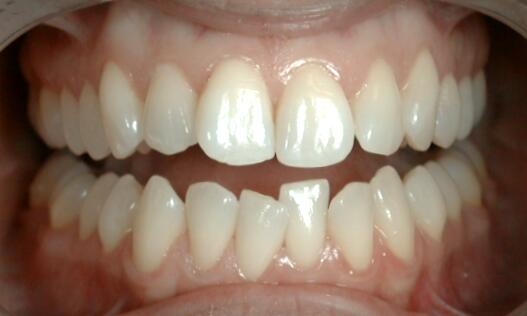
And since this process is not momentary, it is usually noticed too late. The price of such inattention is deleting 8-ok and wearing braces.
So, to summarize, in the vast majority of cases eights are a real headache, both for patients and dentists. To modern man(if he does not live in the forest the life of our distant ancestors) they are really needed insofar as. Those. if your wisdom teeth have grown exactly and in their place, you are able to care for and cherish them along with everyone else, then, thank God! Let them chew. Although I can admit from my own experience, such lucky people are an overwhelming minority. If signs of one of the above-mentioned problems appear, then there is no need to hesitate, be afraid and regret losing a part of yourself... Wisdom teeth are far from the most valuable thing about us. And without them, life does not get worse, but rather the opposite. This “on the contrary” is what I wish for you!.. With or without wisdom teeth.
The eruption of wisdom teeth is a very painful and unpleasant process. Only a few manage to avoid it. In force physiological characteristics For some lucky people, wisdom teeth never erupt, remaining in their infancy for the rest of their lives. Others experience discomfort and discomfort can't be avoided.
As long as the tooth itself grows, a person does not experience any problems. Problems appear when the crown of the tooth reaches the gum and begins to break through it, making its way up. It is especially painful if the tooth is positioned incorrectly and touches neighboring teeth or the cheek.
There is no need to be afraid - a wisdom tooth growing horizontally is not an isolated phenomenon. Many patients come to the dentist with a similar complaint, and, as a rule, the problem is easily solved.
Why does a wisdom tooth grow into the cheek?
Absolutely all people have the rudiments of the last, eighth molars on the edges of each jaw. They are formed at birth. But first, when milk teeth are replaced by molars, the incisors are cut, then the canines, then the chewing molars.
However, they often do not have enough space, especially if the jaw and teeth grow and develop with at different speeds. The eighth molar, which appears the last, already at the age of 18 to 25 years, turns out to be pushed deeper. There is no room for him anymore. And it cuts through in the direction and in the zone where access is still open.
Why is it dangerous?
 It’s not worth talking about how a person feels if a wisdom tooth grows into the cheek. But in addition to discomfort, this phenomenon threatens with quite dangerous consequences.
It’s not worth talking about how a person feels if a wisdom tooth grows into the cheek. But in addition to discomfort, this phenomenon threatens with quite dangerous consequences.
- Injury to the mucous membrane. The edges of the tooth will constantly scratch your cheek. And the worst thing is that wounds and abrasions will not heal, since the irritant does not disappear. This means that access for pathogenic microorganisms always open. A non-healing wound on the mucous membrane is all the conditions for the proliferation of bacteria and various infections. Stomatitis, gingivitis and other diseases will not keep you waiting if the wisdom tooth grows horizontally and injures the cheek.
- Possibility of suppuration. If the problem long time is not eliminated, if stomatitis develops and the wound increases in size, turning into real erosion, the risk of hematoma formation is very high. Erosion will begin to fester, dead particles will accumulate in the mucous membrane. As a result, the gums, cheek, and in severe cases, the entire half of the face on the side on which the wisdom tooth grew incorrectly may swell. Treatment of hematoma is only surgical; you will need to open the gum, and sometimes the cheek with outside to remove pus. After the operation, a course of antibiotic therapy is carried out.
- Change in bite. Malocclusion in adulthood means discomfort when chewing food, headaches, pain in the jaw and neck. With malocclusion, the load on the teeth is distributed incorrectly. And this can lead to their premature destruction.
- Development of periodontitis, formation of fistulas and cysts. The roots of wisdom teeth are more massive and larger than those of ordinary teeth. Therefore, if they collide under the gum, the roots of the eighth molar always win. In this case, the displaced roots of neighboring teeth can break, crumble and suppurate. And this threatens serious inflammation, often with an abscess and fever.
- Education cancerous tumor. This is the most dangerous consequence, rare, but quite possible. When the horizontally located last molar constantly presses on the cheek, the mucous membrane begins to adapt to the forced conditions. It becomes compacted and deformed. Harmless nodules under the influence of the slightest negative factors from the outside or from the inside can begin to degenerate into a malignant tumor.
 A wisdom tooth takes a very long time to cut – from seven days to several weeks and even months. It is difficult to skip this process, since in most cases the gums hurt, swell, sometimes the body temperature rises, and it is difficult for the patient to chew, open his mouth wide and speak. By consulting a doctor in time, you can avoid all these symptoms and possible complications.
A wisdom tooth takes a very long time to cut – from seven days to several weeks and even months. It is difficult to skip this process, since in most cases the gums hurt, swell, sometimes the body temperature rises, and it is difficult for the patient to chew, open his mouth wide and speak. By consulting a doctor in time, you can avoid all these symptoms and possible complications.
What to do if your wisdom tooth grows horizontally
In cases where a wisdom tooth grows into the cheek and causes injury to the mucous membrane, only a doctor can help. Usually, the fact that a tooth is cut incorrectly is noticeable at the very beginning of the process. Moreover, it is very painful. If you contact your dentist at this stage, in most cases he will advise you to remove it before it has erupted and started creating real problems.
If for some reason you didn’t do this, you drowned out the pain with analgesics and the “wrong” tooth still grew horizontally, it’s time to remove it now. You will have to do this anyway sooner or later, so it’s better not to delay, so as not to add a whole list to the problem unpleasant diseases oral cavity.
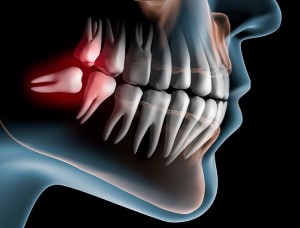 Information: modern diagnostic equipment allows even adolescence determine how problematic the eighth molar will be. If there are prerequisites for it to grow incorrectly, it is recommended to immediately undergo surgery to remove it. It will be faster, safer and more painless. You shouldn’t refuse: according to statistics, in 95% of cases, wisdom teeth still have to be removed either immediately after eruption or within a year after it.
Information: modern diagnostic equipment allows even adolescence determine how problematic the eighth molar will be. If there are prerequisites for it to grow incorrectly, it is recommended to immediately undergo surgery to remove it. It will be faster, safer and more painless. You shouldn’t refuse: according to statistics, in 95% of cases, wisdom teeth still have to be removed either immediately after eruption or within a year after it.
What will the doctor do, how is the operation performed? You need to prepare for the fact that it will not be possible to quickly remove an incorrectly grown molar. The problem is that its roots can be curved, grow in different directions, and be covered by the roots of neighboring teeth. To get to them, you often have to open the gums
- First, a thorough visual inspection must be carried out and x-ray. In some cases, when a defective wisdom tooth is covered by other teeth or tissues, it is necessary to computed tomography to get a clear picture of the location and size of the roots. Keep this in mind when choosing a dental office - the district clinic may not have such equipment.
- The doctor will then administer anesthesia. Without freezing, tooth extraction surgery is never performed. Warn your doctor if you are allergic or take any serious medications for chronic diseases or you have a history of poor tolerance to anesthetics.
- If there is no destruction and access is open, after the pain medication has taken effect, the wisdom tooth will be removed. If there is no access, the doctor will carefully cut the gum and separate soft fabrics from the bones and then will carry out the extraction without any hindrance.
- At difficult removal When the roots are too massive or curved, filing of the tooth may be necessary. In this case, its roots will be removed in fragments. It is important not to miss a single piece or fragment - this can lead to suppuration of the wound after removal.
- Then everything happens according to the standard scheme. There should be a formation in the hole blood clot– the doctor will make sure of this before sending you home. If the gums are opened and pus is removed, additional drainage may be installed.

After the wound has healed and tissue has been restored (usually 5-7 days), you will need to see a specialist again.
How to behave after removal of a difficult wisdom tooth
As was said, surgery to remove a wisdom tooth, especially if it has grown crooked, is always more difficult than removing a regular one. This is explained by the size and shape of the roots, as well as its inaccessibility. Therefore, caring for the oral cavity after surgery should be more thorough.
In the first few days, until the wound is completely healed, you must rinse your mouth with a disinfectant. Ideally, take baths several times a day using a solution of soda, salt and iodine. For one and a half glasses warm water take a quarter teaspoon of soda, sea salt and 4-5 drops alcohol solution iodine from the pharmacy. Baths are done every two hours.
You can rinse after eating oral cavity weak green tea without sugar, a decoction of chamomile, linden, St. John's wort.





